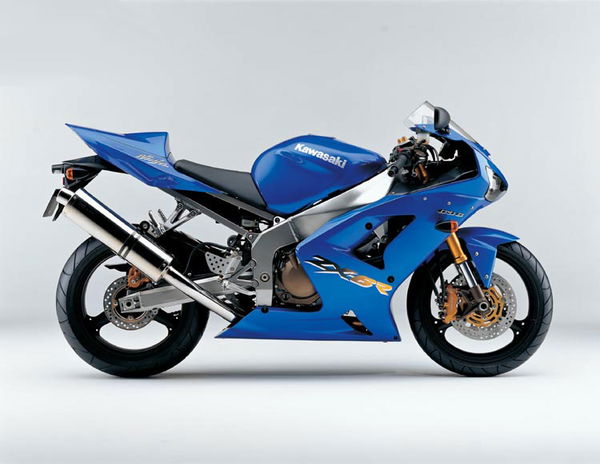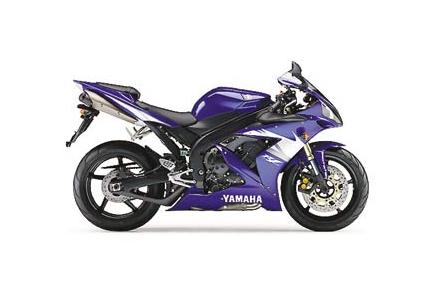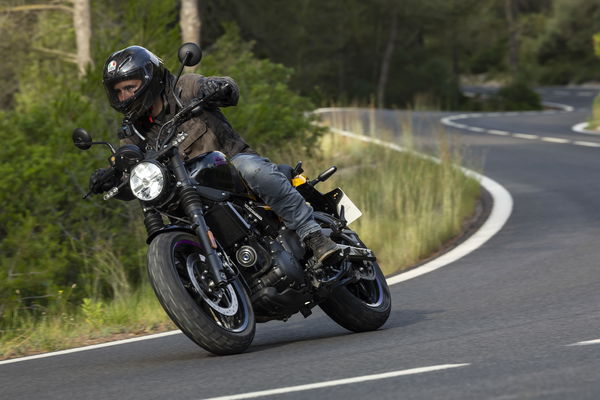ZX-6R Ninja B1H-B2H (2003 - 2004) review
Slick styling, a strong motor and chassis tweaks put the ZX-6R right back up there. Big bore motor may be cheating, but who cares when it's this much fun?

You can see the influences from both the ZX-10R and MotoGP ZX-RR machines. The new 6R has a low screen and flowing contours all the way back to the tail unit, then up close the smooth curves of the nose, lights and front mudguard go some way to justifying Kawasaki’s claim that this is the most aerodynamic Ninja to date. With everything pulled in, rear turbulence has been greatly reduced behind the rider, adding to comfort and top speed. The speedo reading rose from 156mph to 165mph in a few seconds just by tucking in properly, which suggested the slippery shape was working well.
Other nice touches are the nicely engineered pillion peg mounts, integrated indicators and lighter ZX-10R-style wheels. The underseat muffler is less tidy and protrudes more than the CBR 600RR’s, but looks good never the less.
On to the fun part. After hopping aboard I found the riding position for me was a tad cramped. The pegs didn’t give me enough legroom, being a touch too high and forward, plus the brake and clutch levers were set too high. The clutch lever will move down but the brake line connections make it difficult to adjust the right hand lever. I admit after riding for a while I got used to these niggles, but were I to own this bike I would make minor alterations to make riding more comfortable.
Its best feature though is the free-revving, 130bhp motor (claimed, and 136 with ram air effect), which starts with a wail around 8000rpm then develops into a full banshee scream en route to the 15,500rpm rev limit. There is no definite powerband but also no boring linear feel either; just a great engine that will never fail to set your pulse racing.
The extra engine performance comes from a combination of new, 38mm oval throttle bodies (keeping the frame slim), bigger intake and exhaust valves, new camshaft profiles and an integral exhaust valve.
Cornering on a partial throttle is silky smooth, and I found I could use a higher gear than I would on a regular 600 having these extra cubes and torque to hand.The gearbox was positive – though not as slick as the CBR’s – but I never came close to missing a gear and I could always shift quickly and with ease.
Third gear is now taller to provide more evenly spaced ratios, although the slight downside is that third gear wheelies are now more of a challenge. That’s probably not a bad thing to be fair, as the phrase ‘custodial sentence’ always springs to mind on those occasions.
Riding fast in a straight line could be done with no hands (although I don’t recommend you try this yourself) as the stiff chassis and special ‘J’ model BT014 Bridgestones work in perfect harmony, but coming down from a fast wheelie or accelerating over an undulating or bumpy surface got my sphincter’s attention on a few occasions. Unlike the last 636 there is no violent headshake, instead more of a slow-motion buckling feeling. I’m sure this could be improved by stiffening the rear suspension but the only safe fix would be a steering damper. There should be no shame in manufacturers fitting these as standard because, as any racer knows, there is always a stability trade-off to get a quick steering bike. They seem to view it as an admission of failure...
Otherwise the new Showa suspension was brilliant and I particularly liked how the new 41mm upside down forks coped on the brakes, giving a nice and progressive weight transfer. The powerful 300mm radially mounted four-piston/four pad calipers also provided a consistent feel throughout the day, with the new petal discs front and rear complementing the fresh new look.
Being a minimalist, I like the single clock dash, but reading the rpm at a glance is impossible. You can use the adjustable shift light for gear changes but now and again I would like to know what is going on with engine speed. Split seconds count for safety more than anything else, and it just takes too long to read the rev counter. The other info is fine with the warning lights, speed and temperature all easy to read.
Personally I think the new shade of Kawasaki green stands out best with the contrasting black sidepanels, frame and bellypan with the candy blue coming a close second. The ‘raw titanium’ option is my least favourite.
I thoroughly enjoyed my short spell with the new Kawasaki. It has a stonking motor, a great personality, is fun to be with and stands out from the crowd. I wouldn’t describe it as perfect, but then perfect
can be a little bit boring. Just look at Michael Schumacher.
The proof for me of how good a bike is whether or not I really want to ride it again. Well, I’m gagging for more of this one, so roll on Spring and a nice dry track.
You can see the influences from both the ZX-10R and MotoGP ZX-RR machines. The new 6R has a low screen and flowing contours all the way back to the tail unit, then up close the smooth curves of the nose, lights and front mudguard go some way to justifying Kawasaki’s claim that this is the most aerodynamic Ninja to date. With everything pulled in, rear turbulence has been greatly reduced behind the rider, adding to comfort and top speed. The speedo reading rose from 156mph to 165mph in a few seconds just by tucking in properly, which suggested the slippery shape was working well.
Other nice touches are the nicely engineered pillion peg mounts, integrated indicators and lighter ZX-10R-style wheels. The underseat muffler is less tidy and protrudes more than the CBR 600RR’s, but looks good never the less.
On to the fun part. After hopping aboard I found the riding position for me was a tad cramped. The pegs didn’t give me enough legroom, being a touch too high and forward, plus the brake and clutch levers were set too high. The clutch lever will move down but the brake line connections make it difficult to adjust the right hand lever. I admit after riding for a while I got used to these niggles, but were I to own this bike I would make minor alterations to make riding more comfortable.
Its best feature though is the free-revving, 130bhp motor (claimed, and 136 with ram air effect), which starts with a wail around 8000rpm then develops into a full banshee scream en route to the 15,500rpm rev limit. There is no definite powerband but also no boring linear feel either; just a great engine that will never fail to set your pulse racing.
The extra engine performance comes from a combination of new, 38mm oval throttle bodies (keeping the frame slim), bigger intake and exhaust valves, new camshaft profiles and an integral exhaust valve.
Cornering on a partial throttle is silky smooth, and I found I could use a higher gear than I would on a regular 600 having these extra cubes and torque to hand.The gearbox was positive – though not as slick as the CBR’s – but I never came close to missing a gear and I could always shift quickly and with ease.
Third gear is now taller to provide more evenly spaced ratios, although the slight downside is that third gear wheelies are now more of a challenge. That’s probably not a bad thing to be fair, as the phrase ‘custodial sentence’ always springs to mind on those occasions.
Riding fast in a straight line could be done with no hands (although I don’t recommend you try this yourself) as the stiff chassis and special ‘J’ model BT014 Bridgestones work in perfect harmony, but coming down from a fast wheelie or accelerating over an undulating or bumpy surface got my sphincter’s attention on a few occasions. Unlike the last 636 there is no violent headshake, instead more of a slow-motion buckling feeling. I’m sure this could be improved by stiffening the rear suspension but the only safe fix would be a steering damper. There should be no shame in manufacturers fitting these as standard because, as any racer knows, there is always a stability trade-off to get a quick steering bike. They seem to view it as an admission of failure...
Otherwise the new Showa suspension was brilliant and I particularly liked how the new 41mm upside down forks coped on the brakes, giving a nice and progressive weight transfer. The powerful 300mm radially mounted four-piston/four pad calipers also provided a consistent feel throughout the day, with the new petal discs front and rear complementing the fresh new look.
Being a minimalist, I like the single clock dash, but reading the rpm at a glance is impossible. You can use the adjustable shift light for gear changes but now and again I would like to know what is going on with engine speed. Split seconds count for safety more than anything else, and it just takes too long to read the rev counter. The other info is fine with the warning lights, speed and temperature all easy to read.
Personally I think the new shade of Kawasaki green stands out best with the contrasting black sidepanels, frame and bellypan with the candy blue coming a close second. The ‘raw titanium’ option is my least favourite.
I thoroughly enjoyed my short spell with the new Kawasaki. It has a stonking motor, a great personality, is fun to be with and stands out from the crowd. I wouldn’t describe it as perfect, but then perfect
can be a little bit boring. Just look at Michael Schumacher.
The proof for me of how good a bike is whether or not I really want to ride it again. Well, I’m gagging for more of this one, so roll on Spring and a nice dry track.
| Dryweight (kg) | 161 |
| Seats | 0 |
| Seat Height (mm) | 825 |
| Suspension Front | Inverted 41mm cartridge fork |
| Suspension Rear | Bottom-Link Uni-Trak with nitrogen-charged shock and piggy-back reservoir |
| Tyres Front | 120/65-ZR17 |
| Tyres Rear | 180/55-ZR17 |
| Brakes Front | Dual 280mm discs with radial mount opposed 4 piston calipers |
| Brakes Rear | Single 220mm disc with single-bore pin-slide |
| Wheelbase (mm) | 1400 |
| Chassis | Perimeter, pressed aluminium |
| Cubic Capacity (cc) | 636 |
| Valves | 16 |
| Max Power (bhp) | 120 |
| Valves Per Cylinder | 4 |
| Cooling | Liquid cooled |
| Stroke Type | Four Stroke |
| Top Speed | 157.6 |
| Max Power Revs | 49.1844 |
| Max Torque Revs | 11939 |
| Standing Quarter Mile - Terminal Speed MPH | 126.57 |
| Standing Quarter Mile - Time | 12.07 |
| Standing Start 0-100mph | 7.5 |
| Time to Top Speed | 37.34 |











